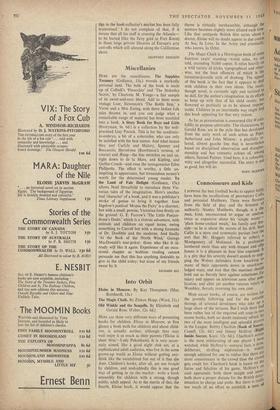Roots, Wrists, and Noses, or the Bald Teddy Bear
MORE competent drawing is done in England now than in Arthur Rackham's time; a little of it—far too little—evades the gross insensitivity of publishers and gets into books for children. The Babar books, I remember, were refused by twelve London publishers. That was back in the Thirties. Rackham, thin, pseudo-grotesque, leukxmic, or Dulac, a little more sophisticated but little less unpleasant, still exemplified the publisher's idea of de luxe illustrations for the young. About that time I once asked one of the more eminent Lon- don art dealers why we could not have an exhibition of Paul Klee (he had never been exhibited in England). The dealer--Rackham's dealer; I see from this biography—shook his sad little head and replied that Klee would be quite unsaleable.
Two points: Klee is fantasy, and Klec was nurtured in a fin-de-siecle climate; he emerged from beginnings which were also, like Rackham's, a little psuedo-gothically art nouveau. Illustrators —if that is all they are—do not emerge, and do not greatly develop, except in facility. But whether they are good or bad partly depends upon the visual company they have kept as students (Babar's Jean de Brunhoff had kept company with a twentieth-century art which still looked nonsense to London publishing houses some thirty years after fauvism). What was Rackham's company? Beardsley, for cer- tain; and Burne-Jones. He is in a way shredded Jones, Jones animated. More exactly he is com- mercialised Beardsley modified by washes of colour, having taken also a long backward look at Diirer of the engravings, not the woodcuts,
Diirer of scrolls, thin scratched lines and arabesques.
The best that could be said for this drawing- room artist ('I don't think you had better keep this lovely book in the nursery, darling') is not really elaborated in this life and works, which piffles on in an atmosphere of Barrie, E. V. Lucas and the worst of de la Marc, suitably introduced with a quote from John Betjcman. The best or most effective in Rackham—rather nastily—is a feeble devilment of thin roots, thin wrists, thin noses and lines in planks, which is the underside of his horrible pretty-prettiness and elegance, the underside of 'Fairies never say "We feel happy": what they say is "We feel dancey,"' a Barrie statement he illustrated.
I would say myself that the illustration children like most is illustration never meant for them, which they find by accident—for instance, wood- cuts of the late fifteenth century. When illustra- tion is meant for them, the artist has a job not to adopt some form of special 'voice' out of Listen with Mother. 'Now, children,' says the drawing. Rackham's drawings are always saying it. The artist avoids that special voice most of all in periods when his art milieu encourages an un- niggling, clear, mediated and selective realism. So there are excellent illustrations in the tradition of mid-nineteenth realism, English and French, to such books as Twenty Thousand Leagues under the Sea or Swiss Family Robinson. Rack- ham and all give me the sick (and gave it to me when I was ten). So does this book about him, so very silly about a man so neat, tidy, prim, skil- ful, empty, precise, punctual, alert, energetic and dull, whose forte was acting in Gilbert and Sol- livan and whose work 'has a Shakespearian breadth and truth to nature.' However, 'his pres- tige in the book-collector's market has been fully maintained.' I do not complain of that, if it means that all his stuff is crossing the Atlantic— to be buried (like the fairy gold in Fort Knox) in those large private libraries of Europe's arty cast-offs which still abound along the Californian shore.
GEOFFREY GRIGSON















































 Previous page
Previous page